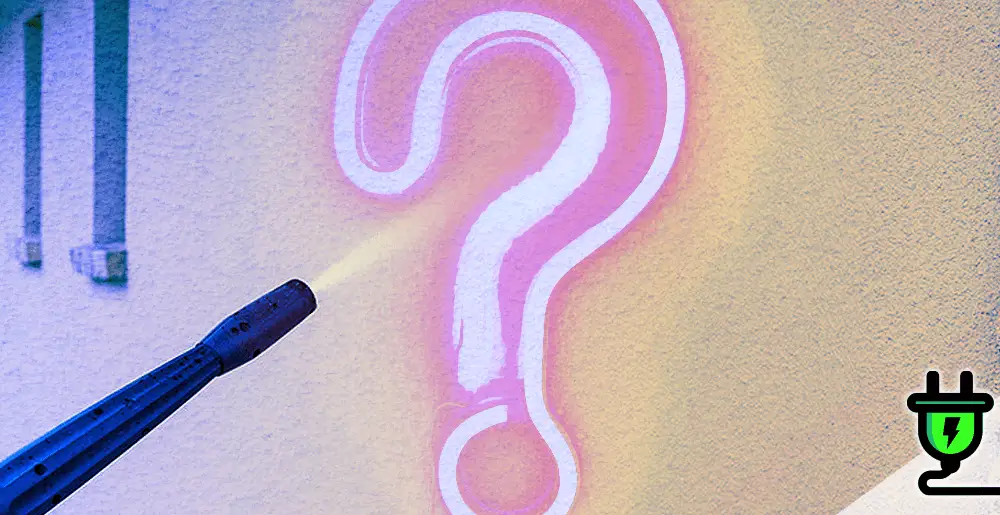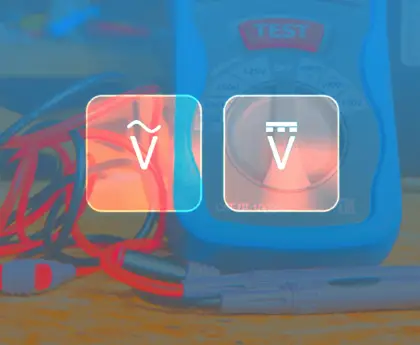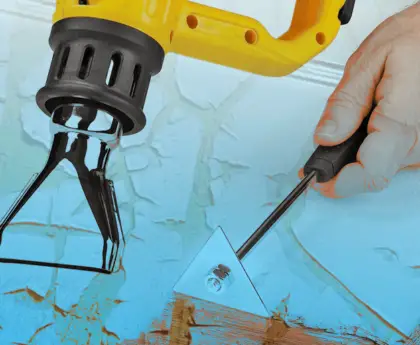Navigating the best methods for cleaning your home’s stucco surface can be daunting. With potential damage lurking behind common power washing practices, it’s important to tread lightly. Can you power wash stucco without damaging the surface?
Yes, using a power washer or pressure washer to clean stucco is perfectly safe. When power washing a stucco wall, maintain a 25- to 40-degree angle between the nozzle and the surface, and use the lowest water pressure setting.
Although, given the intensity of a power washer and sometimes delicate nature of stucco, seeking the help of a professional is always best.
Stucco is a favored choice for many property owners because of its ability to enhance the exterior look and serve as insulation. Made from eco-friendly materials like limestone, concrete, and sand, stucco is both aesthetically pleasing and sustainable.
However, its textured surface tends to trap dirt, grime, mold, and algae. If left unchecked, these contaminants can not only tarnish the look of the property but also lead to lasting damage.
That’s why it’s important to maintain the stucco by cleaning it regularly, ideally two to three times a year.
This article will guide you through a more gentler and equally effective way to ensure your stucco looks pristine without causing any harm. Ready? Let’s dive in!
The Potential Damage of Power Washing Stucco
Power washing can be dangerous for stucco surfaces due to the risks of applying excessive force, which can result in cracks, chips, and damage to the surface.
Why power washing can be dangerous for stucco surfaces
Power washing unleashes a forceful stream of water that can cause significant damage to stucco surfaces. This surge poses a risk, often leading to chips and cracks on the exterior of your home.
When these tiny fissures appear, they create pathways for moisture. This unintended consequence might lead to extensive repairs or even replacement of entire sections if left untreated over time.
Notably, pressure washers with 1500 – 2800 PSI capabilities usually suit cleaning tasks; anything beyond this range risks unwanted impact on stucco structures.
While the shortcuts power washing offers may seem appealing, it’s pertinent we consider its repercussions before acting impulsively.
The risks of applying excessive force
Applying excessive force when power washing stucco surfaces can lead to serious damage and costly repairs. The intense pressure from the water can cause chips, cracks, and even break off pieces of the stucco.
It’s important to use a pressure washer with the right PSI capabilities and avoid applying too much force to protect the integrity of the surface. Additionally, it is crucial to use wide-angle nozzles instead of narrow ones as they disperse water evenly and reduce the risk of causing damage.
By being cautious and using proper techniques, you can keep your stucco looking clean without risking any harm to its structure or appearance.
Alternative Cleaning Methods for Stucco Surfaces
To clean stucco surfaces without causing damage, gentle cleaning solutions and techniques are recommended. Using a soft brush or sponge can effectively remove stains, while mold and mildew can be tackled with appropriate cleaning products.
Gentle cleaning solutions and techniques
To safely clean stucco surfaces without causing damage, it is important to use gentle cleaning solutions and techniques. Instead of using a high-pressure power washer, consider using a soft brush or sponge for stains on the stucco.
For removing mold and mildew, try a mixture of vinegar and water or a homemade stucco cleaner. By opting for these alternative methods, you can effectively clean your stucco without risking any costly damage.
Using a soft brush or sponge for stains
To effectively remove stains from stucco surfaces, it is best to use a soft brush or sponge. Gently scrubbing the stained area with these tools can help loosen and lift the dirt or grime without causing any damage to the stucco surface.
Whether it’s a stubborn stain or just general discoloration, this method allows for precise cleaning while minimizing the risk of scratching or chipping the stucco. Remember to use gentle pressure when using a soft brush or sponge and take your time to ensure thorough cleaning without compromising the integrity of your stucco.
Removing mold and mildew
Mold and mildew can be common problems on stucco surfaces, especially in damp or humid environments. To remove mold and mildew from your stucco, it is important to act promptly before they cause further damage.
One effective method is to create a cleaning solution using bleach and water. Simply mix one part bleach with three parts water and apply the solution to the affected areas. Allow it to sit for about 15 minutes, then use a soft brush or sponge to scrub away the mold and mildew.
Rinse thoroughly with clean water afterward to ensure all traces are removed. Regularly inspecting your stucco surfaces for any signs of mold or mildew growth will help you catch these issues early and prevent them from spreading.
How to Properly Clean Stucco
Inspect and repair the stucco surface for any cracks or damages before cleaning it.
Inspecting and repairing the surface beforehand
Before cleaning stucco surfaces, it is crucial to inspect and repair any damaged areas. Cracks or chips in the stucco can worsen if not addressed before cleaning. Carefully examine the surface for any signs of damage and make necessary repairs before proceeding with the cleaning process.
By taking this step, you ensure that the stucco is in good condition and ready to be cleaned without risking further harm to its integrity.
Preparing a cleaning solution
To properly clean stucco surfaces, it is important to prepare a cleaning solution that is effective yet gentle. One option is to mix equal parts of water and bleach, which can help remove stains and kill mold or mildew.
Another alternative is using a mixture of vinegar and water for a natural cleaning solution. It’s crucial to follow safety guidelines when handling chemicals and wear protective gear such as gloves and goggles.
Remember, the right cleaning solution will ensure that your stucco surfaces are thoroughly cleaned without causing any damage.
Using low-pressure and wide-angle nozzles
To safely clean stucco surfaces, it is recommended to use low-pressure and wide-angle nozzles when using a pressure washer. This helps prevent the risk of causing any damage to the delicate stucco surface.
By adjusting the nozzle settings to low pressure, you can ensure that the force of water is gentle enough not to chip or crack the stucco. Additionally, using wide-angle nozzles spreads out the water spray over a larger area, further reducing the chances of any concentrated force that could harm the stucco surface.
These precautions are crucial in maintaining the integrity and longevity of your stucco exterior while effectively removing dirt, stains, and mildew without causing unnecessary damage.
Rinse the stucco surface thoroughly
After cleaning the stucco surface using a gentle cleaning solution and low-pressure washing, it is crucial to rinse the stucco thoroughly. This step helps remove any remaining dirt, debris, or cleaning solution residue from the surface.
A thorough rinse ensures that no residue is left behind that could potentially damage or degrade the stucco over time. By rinsing with clean water, you can leave your stucco looking fresh and vibrant while maintaining its integrity for years to come.
Tips for Maintaining Stucco Surfaces
Regularly inspect and repair any cracks or damage in the stucco surface to prevent further deterioration. Prevent dirt and stains from building up by regularly cleaning the stucco with gentle solutions and techniques.
Apply protective coatings or sealants to protect the stucco from water damage and maintain its appearance. Consider consulting a professional for specialized cleaning needs, especially for larger areas or stubborn stains.
Regular inspections and repairs
Regular inspections and repairs are crucial for maintaining the longevity and appearance of stucco surfaces. By conducting routine checks, you can identify any small cracks or damage early on before they escalate into bigger issues.
Regularly inspecting the stucco allows you to address any repairs promptly, ensuring that water or moisture does not seep behind the surface and cause additional damage. Additionally, staying proactive with inspections helps to prevent dirt and stains from building up over time, keeping your stucco looking clean and well-maintained.
Preventing dirt and stains from building up
Regular maintenance is key to preventing dirt and stains from building up on stucco surfaces. By consistently keeping your stucco clean, you can avoid the need for more intensive cleaning methods in the future.
One way to do this is by regularly inspecting your stucco for any signs of dirt or stains and addressing them promptly. Additionally, applying protective coatings or sealants can help create a barrier that prevents dirt from sticking to the surface.
Remember to consult with a professional if you require specialized cleaning or maintenance for your stucco surfaces to ensure they stay looking their best.
Applying protective coatings or sealants
Applying protective coatings or sealants is a crucial step in maintaining the longevity of stucco surfaces. These coatings provide an additional layer of protection against moisture, dirt, and stains, helping to prevent damage and extend the lifespan of the stucco.
By applying a protective coating or sealant regularly, you can enhance the durability of your stucco and minimize the need for costly repairs. This simple yet effective maintenance practice can significantly contribute to preserving the beauty and condition of your stucco surfaces over time.
Consulting a professional for specialized cleaning
Consulting a professional for specialized cleaning is highly recommended when it comes to stucco surfaces. These experts have the knowledge and experience to assess the condition of your stucco and determine the best cleaning approach.
They are aware of the specific techniques and products required to safely remove dirt, stains, mold, or mildew from your stucco without causing any damage. Moreover, professionals can provide valuable advice on how to maintain and protect your stucco surface in the long run.
So if you want peace of mind knowing that your stucco will be cleaned properly and effectively, reaching out to a professional is definitely worth considering.
Can You Power Wash Stucco FAQs
Can you power wash stucco?
Yes, you can power wash stucco to remove dirt, grime, and stains from the surface.
Will power washing damage the stucco?
Power washing can potentially damage stucco if not done correctly. It’s important to use a low-pressure setting and keep the water stream at an angle to prevent any harm.
Are there any precautions I should take before power washing stucco?
Before power washing stucco, cover any nearby plants or delicate objects with plastic sheets or tarps to protect them from water and debris.
Do I need special cleaning solutions for power washing stucco?
No, plain water is usually sufficient for cleaning stucco using a power washer. However, if there are stubborn stains or mold/mildew growth, you may consider using a mild detergent solution specifically designed for exterior surfaces.
Conclusion: Can You Power Wash Stucco?
Truth is, power washing stucco can be risky and potentially damaging to the surface. It is crucial to use proper techniques and equipment, such as a pressure washer with low PSI capabilities and a soap nozzle tip.
Alternatively, you can also clean stucco using gentle methods like vinegar or homemade cleaners. Remember to prioritize regular maintenance and consult professionals for specialized cleaning needs.






